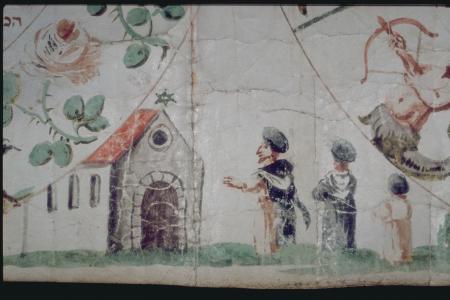Obj. ID: 200
Hebrew Illuminated Manuscripts IM Illustrated Esther Scroll with Roundels, Alsace (?), first quarter of the 18th century

In this richly decorated megillah, a variety of motifs in a unique arrangement fills all the available space on each membrane. The Hebrew text of the Book of Esther is written within mostly circular text panels (cols. 1-8 and 11), but the text Haman's sons by name (Es. 9:6-10) is written in the most popular layout with lines divided into two half-columns. The "rings" surrounding the text are decorated with figures of heroes of the Esther story, animals (including griffins) and birds, flowers (mainly roses), fruits (mainly grape bunches) and trees, and signs of the Zodiac. The spaces between the roundels are filled with illustrations from the Book of Esther and its midrashim, as well as portraits of the Purim story's protagonists.
It seems that this scroll and two other scrolls featuring the same style (see "Related objects) were executed by the same artist, although two of them are decorated with roundels while the third one is decorated with octagons.
sub-set tree:
O | Ornamentation: | Foliate and floral ornaments | Floral motif
A | Animals and Beasts
Z | Zodiac Signs
B | Bird
F | Flower
E | Esther, Book of (following the order of the story) | Esther story protagonists
J | Jews
H | Human Figure
A | Angel , (Sandalfon (angel)), (Metatron (angel))
G | Griffin
F | Fruits
T | Tree
M | Musician
J | Jester
O | Ornamentation: | Main text framed
|
The scroll is preserved in good condition, although its final part is damaged - the membrane is crumpled and the decorations are slightly visible.
The Book of Esther in Hebrew
The scroll is formed of 4 sheets, in total containing 12 columns of text with 23-26 lines of different lengths, except for col. 10 which has 11 lines divided into two half-columns.
The number of columns of text per sheet: no. 1 - 2, nos. 2 and 3 - 3, no. 4 - 4.
The text is written in Hebrew square Ashkenazi script in dark brown-black ink on parchment membranes.
The letters ח (Es. 1:6) and ת (Es. 9:29) and the letters of the name of God are enlarged and bolded. Other enlarged and diminished letters are included in col. 10.
There are some corrections and erasures in the text.
The ruling is invisible.
The pricking on the membranes' edges can be seen.
The membranes of the scroll are glued together.
The Jewish World 365 Days, from the Collections of The Israel Museum, Jerusalem, New York 2004, 182-183.
















